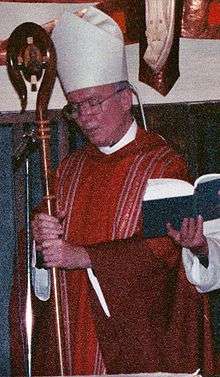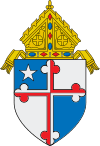James Stafford
James Francis Stafford (born July 26, 1932) is an American cardinal of the Catholic Church. He served as Major Penitentiary of the Apostolic Penitentiary from 2003 to 2009.[1] He previously served as President of the Pontifical Council for the Laity (1996–2003), Archbishop of Denver (1986–1996), Bishop of Memphis (1982–1986), and Auxiliary Bishop of Baltimore (1976–1982).[2] He was elevated to the cardinalate by Pope John Paul II in 1998.[3]
James Francis Stafford | |
|---|---|
| Major Penitentiary Emeritus of the Apostolic Penitentiary Archbishop Emeritus of Denver | |
 | |
| Archdiocese | Denver |
| Installed | October 4, 2003 |
| Term ended | June 2, 2009 |
| Predecessor | Luigi De Magistris |
| Successor | Fortunato Baldelli |
| Other posts | Cardinal Priest of San Pietro in Montorio |
| Orders | |
| Ordination | December 15, 1957 by Martin John O'Connor |
| Consecration | February 29, 1976 by William Donald Borders, Lawrence Shehan, and Thomas Austin Murphy |
| Created cardinal | February 21, 1998 by Pope John Paul II |
| Rank | Cardinal-Priest |
| Personal details | |
| Born | July 26, 1932 Baltimore, Maryland |
| Denomination | Catholic (Roman Rite) |
| Previous post |
|
| Motto | IN PRINCIPIUM ERAT VERBUM In the beginning was the word |
| Styles of James Francis Stafford | |
|---|---|
 | |
| Reference style | His Eminence |
| Spoken style | Your Eminence |
| Informal style | Cardinal |
| See | Denver (Emeritus) |
Early life and education
James Stafford was born in Baltimore, Maryland, the only child of Francis Emmett and Mary Dorothy (née Stanton) Stafford.[4] His father was the owner of a furniture store, which had been opened by his grandfather (an Irish immigrant) in 1902.[5] He was raised in Catonsville, and graduated from Loyola High School in 1950.[5] He then entered Loyola College in Baltimore with the intent of pursuing a career in medicine.[6] However, in 1952, the death of a close friend in a car crash caused him to rethink his future and to enter St. Mary's Seminary in Baltimore.[6]
Stafford attended St. Mary's Seminary for two years before being sent by Archbishop Francis Keough to continue his studies in Rome at the Pontifical North American College and the Pontifical Gregorian University.[3] He earned a Licentiate of Sacred Theology from the Gregorian in 1958.[6]
Priesthood
While in Rome, Stafford was ordained to the priesthood by Bishop Martin O'Connor on December 15, 1957.[2] He was ordained alongside Edward Egan, who would become a cardinal and Archbishop of New York.[7] His first assignment, after returning to the United States, was as assistant pastor at the Immaculate Heart of Mary Church[8] in Baltimore, where he remained until 1962.[1] He then studied at the Catholic University of America in Washington, D.C., where he earned a Master of Social Work degree in 1964 with a thesis on the foster care of children.[3]
From 1964 to 1966, Stafford served as assistant director of the archdiocesan Catholic Charities and assistant pastor of St. Ann Church[9] in Baltimore.[1] He was later named director of the Archdiocesan Catholic Charities by Cardinal Lawrence Shehan in 1966, serving for ten years.[5] In 1970, he was created a Chaplain of His Holiness by Pope Paul VI.[3] He was elected president of the Presbyteral Senate for the archdiocese the following year.[1] He also helped reorganize the central services of the archdiocese and create its collegial structures.[6]
Episcopacy
Auxiliary Bishop of Baltimore
On January 11, 1976, Stafford was appointed Auxiliary Bishop of Baltimore and Titular Bishop of Respecta by Pope Paul VI.[2] He received his episcopal consecration on the following February 29 from Archbishop William Borders, with Cardinal Shehan and Bishop Thomas Murphy serving as co-consecrators, at the Cathedral of Mary Our Queen.[2] He selected as his episcopal motto: In principium erat Verbum, which is Latin for: "In the beginning was the Word" (John 1:1).[3]
As an auxiliary bishop, he served as vicar general of the Archdiocese of Baltimore from 1976 to 1981.[1] From 1978 to 1984, he led the U.S. Catholic Conference Commission on Marriage and Family Life.[6] He also served as administrator of Sts. Philip and James Church[10] (1980–1981).[1] He attended the Fifth Ordinary Assembly of the Synod of Bishops in Vatican City from September to October 1980.[3]
Bishop of Memphis
On November 17, 1981, Stafford was appointed the second Bishop of Memphis, Tennessee, by Pope John Paul II.[2] He was installed on January 17, 1982.[5] During his tenure, he revised the structure of the Pastoral Office, improved the fiscal conditions of the diocese, and concentrated on the evangelization of African Americans.[11]
In addition to his duties in Memphis, he was chairman of the USCCB Commission for Ecumenical and Interreligious Affairs (1984–1991) and co-president of the Dialogue between Roman Catholics and Lutherans (1984–1997).[1]
Archbishop of Denver
Following the death of Archbishop James Casey, Stafford was appointed the third Archbishop of Denver, Colorado, on June 3, 1986.[2] He was installed at the Cathedral of the Immaculate Conception on the following July 30.[5]
During his tenure, he hosted the 1993 World Youth Day in Denver, which was the first WYD in North America. In his last year as archbishop, he launched the first capital campaign in forty years and a "Strategic Plan" for Catholic schools.[6]
Successful Reform of the Denver Roman Catholic Seminary
Upon his arrival in Denver in 1986, Stafford was faced with many complaints about the teaching of the faith at his Archdiocesan Seminary, St. Thomas. Since the 1960s the seminary had been owned and run by the Vincentian Fathers and there were many complaints both about the tolerance in the seminary for dissent from Church teaching and the same among seminary faculty. According to Michael Rose, "the problems, moral and pedagogical, were well known and documented" at St. Thomas.[12][13] Rumors of tolerance for homosexual practice had been rampant since the years of Archbishop James Casey. After seven years trying to get the Vincentian Fathers to fix things, Stafford gave up in 1995 and shut the seminary permanently and fired the Vincentian Fathers. He then worked to find a new team to re-open the institution with entirely new staff and under a new name. Although the actual opening in 1999-2000 would be credited to the new Archbishop, Charles Chaput, the entire plan had been crafted by Stafford with the help of a young Fr. Samuel Aquila who would be founding Rector. The closure of four years also allowed a cleaning house among the seminarians and an aggressive new promotion of the priesthood which resulted in growth in those years from 29 seminarians in 1995 to 68 in 1999.[14] Since 2005, when Archbishop Chaput ordained 7 men to the priesthood (the first group only trained at the new seminary), the Archdiocese has ordained an average of 8 men per year. For a Diocese of only just over 300,000 Catholics, this makes it the highest number of ordinations per capita of any Diocese in the USA.
Career in the Roman Curia
Archbishop Stafford was appointed president of the Pontifical Council for the Laity on August 20, 1996, he became Cardinal-Deacon of Gesù Buon Pastore alla Montagnola in the consistory of 1998.
In 2003, Cardinal Stafford was appointed Major Penitentiary, overseeing matters pertaining to indulgences and the internal forum of the Church. He was thus one of the highest ranking American members of the Roman Curia and the second to serve as Major Penitentiary, the other being William Wakefield Baum. The Major Penitentiary is one of the few Curia officials whose office is not automatically suspended upon the death of the pope, and is the only one allowed to be in contact with anyone outside the conclave.
In accordance with canon 354 of the Code of Canon Law, Cardinal Stafford submitted his letter of resignation to Pope Benedict XVI on the occasion of his 75th birthday in 2007. On June 2, 2009, Pope Benedict appointed as his successor Fortunato Baldelli, who was then Apostolic Nuncio to France.[15]
Stafford was one of the cardinal electors who participated in the 2005 papal conclave that selected Pope Benedict XVI.
On March 1, 2008, Cardinal Stafford took the option, after ten years as a Cardinal Deacon, for promotion to the rank of Cardinal-Priest, and was assigned the titular church of San Pietro in Montorio.[16]
In 2009, he was awarded an honorary doctorate by the Dominican School of Philosophy and Theology and inducted into their College of Fellows.
Criticism of Barack Obama
The online version of the National Catholic Reporter reported on November 19, 2008, that Cardinal Stafford harshly criticized President-elect Barack Obama, saying he has "an agenda and vision that are aggressive, disruptive and apocalyptic".[17]
The story was first reported by The Tower, the student newspaper of the Catholic University of America, where Stafford made those remarks.
Saying that the United States experienced a "cultural earthquake" when Obama was elected president November 4, 2008, Stafford said the president-elect "appears to be a relaxed, smiling man" with rhetorical skills that are "very highly developed". "But under all that grace and charm, there is a tautness of will, a state of constant alertness, to attack and resist any external influence that might affect his will", he added. The cardinal compared the upcoming years of the Obama administration to "Jesus' agony in the Garden of Gethsemane".[18]
The Catholic News Agency revealed more details about the highly controversial words of the cardinal on November 17, 2008: "If 1968 was the year of America's 'suicide attempt,' 2008 is the year of America's exhaustion," he said, contrasting the year of publication of Humanae vitae with this election year. "For the next few years, Gethsemane will not be marginal. We will know that garden," Cardinal Stafford told his audience.[19] Catholics who weep the "hot, angry tears of betrayal" should try to identify with Jesus, who during his agony in the garden was "sick because of love". The cardinal also attributed America's decline to Supreme Court decisions such as the 1973 ruling in Roe v. Wade, which imposed "permissive abortion laws nationwide".
See also
- American bishops serving outside the United States
- Catholic Church hierarchy
- Catholic Church in the United States
- Historical list of the Catholic bishops of the United States
- List of Catholic bishops of the United States
- Lists of patriarchs, archbishops, and bishops
References
- "STAFFORD Card. James Francis". Holy See.
- "James Francis Cardinal Stafford". Catholic-Hierarchy.org. David M. Cheney. Retrieved January 21, 2015.
- Miranda, Salvador. "STAFFORD, James Francis (1932– )". The Cardinals of the Holy Roman Church.
- "Archived copy". Archived from the original on December 30, 2017. Retrieved August 30, 2015.CS1 maint: archived copy as title (link)
- Noel, Thomas J. "Vehr: The Flowering of Catholicism (1931–1967)". Colorado Catholicism. Archived from the original on August 21, 2008.
- "Most Rev. J. Francis Stafford". Roman Catholic Archdiocese of Baltimore. Archived from the original on December 12, 2010.
- Miranda, Salvador. "EGAN, Edward Michael (1932– )". The Cardinals of the Holy Roman Church. Archived from the original on February 15, 2013. Retrieved August 2, 2011.
- "immaculateheartofmary.com". immaculateheartofmary.com. Retrieved December 30, 2012.
- "anchoredinfaith.com". anchoredinfaith.com. Retrieved December 30, 2012.
- "philipandjames.org". philipandjames.org. Retrieved December 30, 2012.
- "History". Roman Catholic Diocese of Memphis. Archived from the original on September 28, 2011.
- Rose, Michael (February 2001). "A Self Imposed Shortage".
- Gorski, Eric (November 29, 2005). "Gay Ordination Ban Affirms Local Practice". Denver Post. Retrieved July 29, 2018.
- Mulqueen, Molly (March 24, 1999). "New Seminary Suggests Big Plans in Denver". Catholic World News. Retrieved July 29, 2018.
- "Cardinal Stafford steps down as Penitentiary Major". Zenit.org. June 2, 2009. Archived from the original on March 2, 2012. Retrieved December 30, 2012.
- "Cardinal Protector". GCatholic.org. Retrieved December 30, 2012.
- http://ncronline3.org/drupal/?q=node/2588
- Grden, Elizabeth (November 14, 2008). "Cardinal at CUA: Obama is 'Aggressive, Disruptive and Apocalyptic'". The Tower. Archived from the original on May 3, 2009. Retrieved November 20, 2008.
- "Cardinal Stafford criticizes Obama as 'aggressive, disruptive and apocalyptic' :: Catholic News Agency (CNA)". Catholic News Agency. November 17, 2008. Retrieved December 30, 2012.
External links
- "Stafford Card. James Francis". Holy See Press Office. Archived from the original on September 4, 2017. Retrieved November 14, 2017.
- Roman Catholic Archdiocese of Denver Official Site
Episcopal succession
| Catholic Church titles | ||
|---|---|---|
| Preceded by Luigi De Magistris |
Major Penitentiary of the Apostolic Penitentiary 2003–2009 |
Succeeded by Fortunato Baldelli |
| Preceded by Eduardo Francisco Pironio |
President of the Pontifical Council for the Laity 1996–2003 |
Succeeded by Stanislaw Rylko |
| Preceded by James Vincent Casey |
Archbishop of Denver 1986–1996 |
Succeeded by Charles Joseph Chaput, OFM Cap |
| Preceded by Carroll Thomas Dozier |
Bishop of Memphis 1981–1986 |
Succeeded by Daniel M. Buechlein, OSB |
| Preceded by - |
Auxiliary Bishop of Baltimore 1976–1981 |
Succeeded by - |



